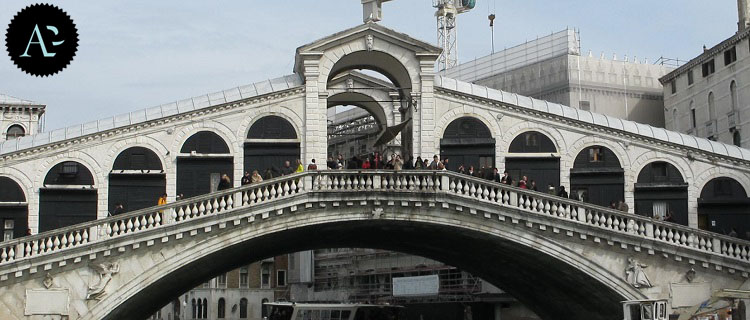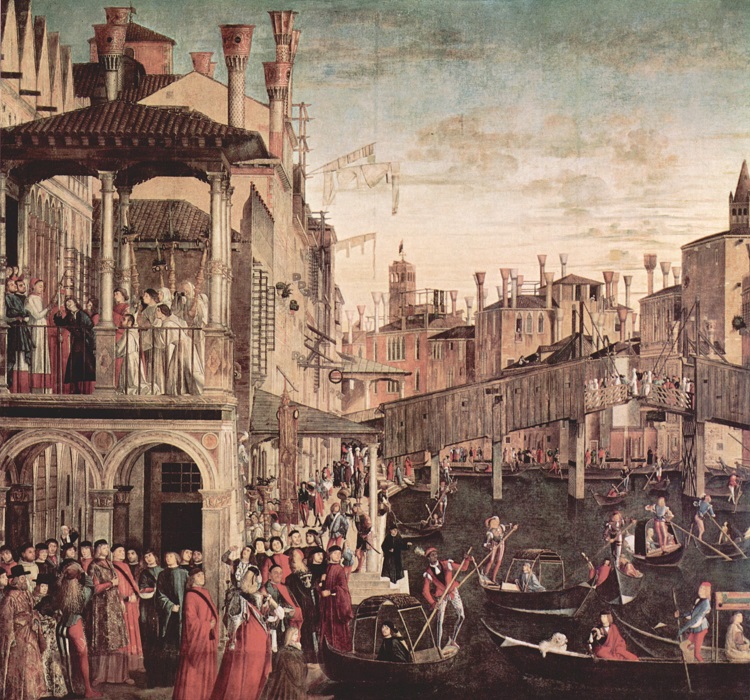
If there is one thing to see in Venice, it is the Rialto Bridge, one of the four bridges spanning the Grand Canal, the oldest and most famous. Needless to say, when I am in Venice, the Rialto Bridge is my reference point for orientation.
In this post I will take you on a fascinating journey into the heart of Venice, to discover one of its most precious bridges. An extraordinary structure that is a work of art in itself and represents a historical and cultural landmark for the city of Venice.
The Rialto Bridge: a historical icon between past and present

“Miracolo della Croce a Rialto” Vittore Carpaccio (1494). Gallerie dell’Accademia
The Rialto Bridge is a living testimony to the ingenuity and skill of Venetian architects and builders. Built in the 12th century, the bridge rises majestically over the Grand Canal, connecting the banks of the sestiere of San Marco and San Polo and has always been a vital crossroads for trade and the daily lives of Venetians.
ORIGINS AND HISTORY OF THE RIALTO BRIDGE
Its construction dates back to around 1181 and initially it was a simple pontoon bridge, which was meant to connect the two banks of the Grand Canal to allow merchants and citizens to travel from one side of the city to the other without wasting too much time. At that time it was called ‘Ponte della Moneta’ (Coin Bridge) because the ancient Mint of the Republic of Venice was located on the eastern bank.
It took the name Rialto Bridge in the mid 13th century, when it was rebuilt entirely in wood and increased its importance as a connecting element to the nearby Rialto market.
After this first reconstruction, numerous other reconstructions followed over the centuries due to damage, destruction or even collapse, such as the one that occurred in 1444. In that year, in fact, the bridge collapsed under the weight of a large number of spectators who were watching the procession of boats of the Marquise of Ferrara, daughter of Alfonso V of Aragon.
After this tragic event, the bridge was rebuilt, still in wood but wider, with shops at the sides and a movable part in the middle to allow taller boats to pass.
A painting by Vittore Carpaccio, kept at the Gallerie dell’Accademia (which is only a few minutes away from the Rialto Bridge) shows the Rialto Bridge at that time.
THE CURRENT RIALTO BRIDGE
At the beginning of the 16th century, discussions began on whether a stronger, stone bridge should be built that would be able to withstand the volume of traffic it was subjected to. In 1551 a call for tenders was issued for the construction of the new bridge and many designs were submitted by various architects and artists, including Michelangelo and Palladio, but in the end the solution proposed by Andrea Da Ponte was chosen.
Work began in 1588 and was completed in 1591 and the result can still be admired today.
The Rialto Bridge consists of a single arch 28 metres long. On each side are six shops that divide it into three paths and in the centre are two large arches with two marble heads.
On each side of the bridge are two significant representations of Venice. On the south side (towards St Mark’s) The Annunciation with the Angel Gabriel, Mary and the dove, indicating the date of Venice’s foundation, 25 March 421; on the north side (towards Piazzale Roma) St Mark and St Theodore, the patron saints of the city.
The atmosphere surrounding the bridge is magical, especially at sunset, when the sun’s rays tint the water and the facades of the surrounding buildings in warm golden hues. Artists and photographers often try to capture this timeless beauty, immortalising the Rialto Bridge in their artwork.
Crossing the bridge is like stepping back in time, imagining life centuries ago, when boats laden with goods plied the Grand Canal, and the Rialto Bridge was the main meeting point for Venetian merchants and citizens. It is a place that embodies the very history and essence of Venice, and offers visitors an authentic and unforgettable experience.

PRACTICAL TIPS AND USEFUL INFORMATION FOR VISITING THE RIALTO BRIDGE
If you plan to visit Venice and the Rialto Bridge, there is some practical information that will make your visit an unforgettable experience.
First of all, it is advisable to plan your visit to the Rialto Bridge at a less crowded time of year. Venice is a very popular destination so, if you can, avoid the summer months and holiday periods to enjoy a quieter visit. If you just can’t avoid the busiest months, then choose to visit the Rialto Bridge at quieter times of the day: early in the morning or late at night.
To reach the Rialto Bridge, you can take a vaporetto (the famous Venetian ferry) along the Grand Canal: Rialto stop.
Or you can choose to take a leisurely stroll through the narrow Venetian calli. If you prefer walking, you can follow the signs for San Marco or San Polo, depending on which side of the city you are coming from.
Once you arrive at the Rialto Bridge, take the time to explore the shops and boutiques that surround it. These small businesses offer a wide range of local products, including jewellery, souvenirs, Murano glass products (masterpieces of glass art can be admired at the Murano Glass Museum) and Venetian culinary delights. It is a great opportunity to take home a piece of Venice and support local artisans.
As you cross the bridge, be sure to stop and take a few photos. The panoramic view of the Grand Canal and the facades of the Venetian buildings is simply breathtaking. The Rialto Bridge offers a multitude of interesting angles and perspectives to capture unique images.
Finally, remember to respect your surroundings. Venice is a fragile and precious city, so avoid littering or damaging historical structures. Follow the directions of the signs and Venetians and enjoy the experience to the fullest, immersing yourself in the unique atmosphere of this iconic architectural structure.




Il charm Árabe di Venezia!
<3